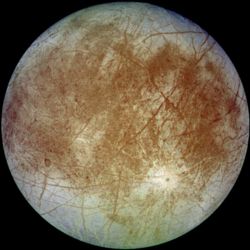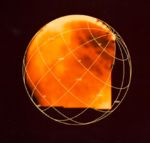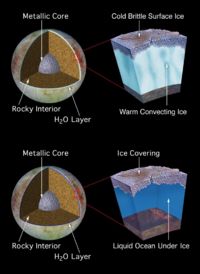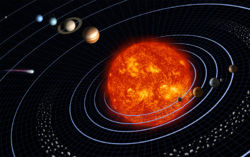Europa (Moon)
 From Conservapedia
From Conservapedia | Europa | |
|---|---|
 True-color image of Europa from the second orbit around it by Galileo. | |
| Date of discovery | January 7, 1610[1] |
| Name of discoverer | Galileo Galilei, Simon Marius[1] |
| Name origin | Phoenician princess from whom Europe gets its name; mistress of Zeus, mother of Rhadamanthus and Minos.[2] |
| Orbital characteristics | |
| Primary | Jupiter |
| Order from primary | 6 |
| Perizene | 664,792 km[3] |
| Apozene | 677,408 km[3] |
| Semi-major axis | 671,100 km[4][5] |
| Orbital eccentricity | 0.0094[4][5] |
| Sidereal month | 3.551181 da[4][5] |
| Avg. orbital speed | 13.74 km/s[4][6] |
| Inclination | 0.470°[4] to Jupiter's equator |
| Rotational characteristics | |
| Sidereal day | 3.551181 da[4] |
| Rotational speed | 31.96 m/s[3] |
| Axial tilt | 0.016°[5] |
| Physical characteristics | |
| Mass | 4.8 * 1022 kg (0.83021% earth)[4][6] |
| Density | 3,013 kg/m³[4][7] |
| Mean radius | 1,560.8 km[7] |
| Surface gravity | 1.3239 m/s² (0.135 g)[4] |
| Escape speed | 2.02 km/s[4][6] |
| Surface area | 30,612,893 km² (6.00175% earth)[3] |
| Minimum temperature | 50 K[8] |
| Maximum temperature | 110 K[8] |
| Composition | Water ice and rock[4] |
| Color | Marble white with reddish-brown streaks |
| Albedo | 0.64[4][6] |
| Magnetosphere | |
| Magnetic flux density | 0.0024 G[9] |
| Magnetic dipole moment at present | 9.13 * 1018 N-m/T[3] |
| Decay time | 861.93 a[3] |
| Half life | 597.45 a[3] |
Contents
- 1 Discovery and naming
- 2 Orbital and rotational characteristics
- 3 Physical characteristics
- 3.1 Controversy over Europa's surface
- 4 Speculation about Life
- 5 Problems for Uniformitarian Theories
- 6 Exploration
- 6.1 History
- 6.2 Plans and proposals
- 7 See also
- 8 References
Discovery and naming[edit]
Galileo Galilei observed Jupiter beginning on January 7, 1610, with his famous telescope. He at first thought he had discovered three stars near Jupiter, but on the next night those "stars" seemed to have moved. (Those "stars" were actually Io, Europa, and Callisto.) He continued to observe Jupiter and its companion "stars" for seven days, during which time a fourth "star" (Ganymede) appeared and all four of these objects appeared to move with Jupiter. Finally he concluded that these objects were not stars at all, but satellites of Jupiter. This was the first direct observation that provided evidence for Nicolaus Copernicus's heliocentric model of the solar system.[1]
Simon Marius claimed to observe Jupiter and these satellites independently of Galileo and beginning five weeks earlier. However, he did not publish his findings, while Galileo published his. Furthermore, Galileo's notes were more reliable and extensive than those of Marius, which is why Ganymede and the three other satellites he observed (Io, Europa, and Callisto) are called the Galilean satellites and not the Galilean-Marian satellites.[1]
Marius does, however, receive credit for providing the names that the satellites have today. He named Ganymede, the largest, for the mythical son of King Tros of Troy, carried aloft to Mount Olympus by Zeus to be the cupbearer to the gods. (The names Zeus and Jupiter refer to the same classical deity from whom Jupiter gets its name.) The other three satellites are named for three of Zeus' most famous mistresses.[1] Marius propounded these names after Johannes Kepler suggested them to him.
Galileo, for his part, called them the "Medicean planets" after the Medici family and simply numbered the moons I, II, III, and IV. The satellites carried these names for two centuries until the discovery of other moons of Jupiter made that naming system untenably confusing.
Orbital and rotational characteristics[edit]

Europa maintains a three-part orbital resonance or Laplace resonance with Io and Ganymede. These three satellites complete their orbits around Jupiter in the ratio 1:2:4. They also conjoin with one another at their apsides, in a mutually self-correcting manner that allows the resonance to persist. (Most such resonances are unstable and end with one or all bodies changing their orbits.)
The origin of the resonance itself is controversial. Peale and Lee, in 2002, presented a model suggesting that this resonance is primordial and thus was part of the Jovian system since its formation.[10] Their model, however, derives from the nebular hypothesis of the formation of the solar system and thus depends on uniformitarian assumptions. Showman and Malhotra suggest a model by which the resonance developed after the solar system had formed.[11]
Most scientists hold that this resonance make Europa warmer than it otherwise would be. This, they say, would explain the persistence of a liquid water ocean on Europa, though it should be far too cold for this.[2] More to the point, the same tidal flexion that might be heating Europa is cited as the cause of the irregular striations observed on Europa's surface.[8]
Physical characteristics[edit]

Europa is likely surfaced with water ice and rock, with a 50-km-deep subterranean ocean deep to this, resting on a silicate floor that surrounds a metallic core. The surface has multiple dark streaks, some measuring 20 km broad. Their origin is uncertain but suspected to be volcanic or geothermal.[2]
Detailed measurements by the spacecraft Galileo (December 19, 1996[9]) revealed that Europa does have its own magnetic field, though it is very weak—only 2.4 milligauss at its equator. This corresponds to a magnetic dipole moment of 9.13 * 1018 N-m/T. (The dipole is oblique to the currents of the magnetic field of Jupiter, and thus it is more likely internal than external.[9]) Europa's mass suggests a magnetic dipole moment at creation of 1.13 * 1022 N-m/T, according to the Russell Humphreys magnetic-field model.[12] Thus the decay time for this field is 861.93 Julian years, and the half-life is 597.45 Julian years. All of the above are consistent with Europa having a small but significantly conductive core and possibly a liquid ocean holding electrolytes in solution.
The Hubble Space Telescope has detected evidence of an "atmosphere" at pressure 10−11 bar, containing oxygen.[2][8] Most authorities do not suggest that this oxygen is biotic. Rather, they suggest that sunlight and the charged particles of Jupiter's radiation belt cause the water ice on Europa to vaporize and then to split into hydrogen and oxygen—and the hydrogen, being much lighter, tends to escape Europa's light gravity (0.135 g) and leave the oxygen.[2][8]

Controversy over Europa's surface[edit]

Faced with the risk of terrestrial contamination of Europa's possible thinly-covered ocean, an event that would severely complicate any evaluation of the finding of extremophiles or other microbes on Europa, led the Galileo mission planners to make a hard decision. They deliberately crash-dived the Galileo orbiter onto Jupiter so that it would never risk crashing onto the surface of Europa.[14][15]
Speculation about Life[edit]
More than any other extraterrestrial body (except perhaps for Mars), Europa has long been the subject of intense speculation as to whether it harbors extraterrestrial life. The Voyager data fueled this speculation, which began with Richard C. Hoagland's startling proposal that Europa might have a liquid ocean that harbored life.[16] NASA authorities, except for Robert Jastrow, were unsympathetic and highly skeptical of Hoagland's theories. Arthur C. Clarke, a prominent science fiction writer, used the concept of life on Europa as a plot point for his novels 2010: Odyssey II (later adapted into the motion picture 2010: The Year We Make Contact) and 2061: Odyssey III.[17]
With the arrival of Galileo and the data from Galileo's early exploration of Europa, the speculation became even more feverish.[2][6][18] Even the finding of sulfuric acid, a harsh chemical, on Europa has not dampened that speculation.[13]
Problems for Uniformitarian Theories[edit]
By far the most salient problem that Europa poses for uniformitarians is its apparent "geologic youth." How such "young" bodies as Europa and its inner neighbor Io came to participate in a three-part orbital resonance with a so-much-"older" body (Ganymede) begs explanation. Those wishing to assert that Io and Europa did indeed form much more recently than did Ganymede (and Callisto, the fourth member of the family of Galilean moons) must be prepared to state where those two bodies came from, if they did not form at the same time as the rest of the solar system.
At least some authorities assert that Io, for example, only looks "young" because its volcanoes are constantly filling in any impact craters that are forming. Others assert that Europa looks "young" because its subterranean liquid ocean, if it has one, is resilient and thus able to absorb most meteor impacts without forming craters.[19] Yet the persistence of the three large impact craters known to exist on Europa contradicts this explanation.
Exploration[edit]
History[edit]

Voyager 1 and Voyager 2 provided richly detailed images and other findings that made possible the first models of Europa's interior and surface composition.
In 1995, the Galileo spacecraft arrived in the Jovian system. After releasing a probe to dive into Jupiter and report on Jupiter's atmosphere, Galileo began a detailed reconnaissance of the Galilean moons. Europa was one of its first targets, on account of the relative safety of a close approach to Europa and the urgency of the speculation about Europa's composition and possible harboring of extraterrestrial life.
Plans and proposals[edit]
The proposed Jupiter Icy Moons Orbiter, which would almost certainly have had Europa as a prime target, has recently been cancelled.[20] But other proposals for further exploration remain under consideration. At least one such proposal calls for a probe to crash through the ice and release a robotic submersible to explore the water beneath the ice.[21]
See also[edit]
- Europa
References[edit]
- ↑ 1.0 1.1 1.2 1.3 1.4 "The Discovery of the Galilean Satellites," JPL, NASA, n.d. Quoted by Hamilton, Calvin J., SolarViews. Accessed February 18, 2008.
- ↑ 2.0 2.1 2.2 2.3 2.4 2.5 2.6 2.7 Arnett, Bill. "Entry for Europa." The
Nine8 Planets, October 1, 2005. Accessed February 29, 2008. - ↑ 3.0 3.1 3.2 3.3 3.4 3.5 3.6 Calculated
- ↑ 4.00 4.01 4.02 4.03 4.04 4.05 4.06 4.07 4.08 4.09 4.10 4.11 "Europa, a Continuing Story of Discovery." Galileo Project/NASA. Accessed February 29, 2008.
- ↑ 5.0 5.1 5.2 5.3 "[Planetary Satellite Mean Orbital Parameters]." Solar System Dynamics, JPL, NASA. Accessed February 29, 2008.
- ↑ 6.0 6.1 6.2 6.3 6.4 6.5 Hamilton, Calvin J. "Jupiter's Moon Europa." Solarviews, 1997. Accessed February 29, 2008.
- ↑ 7.0 7.1 "Planetary Body Physical Parameters." Solar System Dynamics, JPL, NASA. Accessed February 29, 2008.
- ↑ 8.0 8.1 8.2 8.3 8.4 8.5 8.6 "Jupiter's Moon Europa." The Planetary Society. Accessed February 29, 2008.
- ↑ 9.0 9.1 9.2 M. G. Kivelson, K. K. Khurana, S. Joy, C. T. Russell, D. J. Southwood, R. J. Walker, C. Polanskey. "Europa's Magnetic Signature: Report from Galileo's Pass on 19 December 1996." Science 276(5316):1239-1241, May 23, 1997. doi:10.1126/science.276.5316.1239 Accessed May 12, 2008.
- ↑ Peale, S. J., and Lee, Man Hoi. "A Primordial Origin of the Laplace Relation Among the Galilean Satellites." Science, 298(5593):593-597, October 2002. Accessed February 18, 2008.
- ↑ Showman, Adam P., and Malhotra, Renu. "Tidal Evolution into the Laplace Resonance and the Resurfacing of Ganymede." Icarus, 127:93-111, 1997. Accessed February 18, 2008.
- ↑ Humphreys, D. R. "The Creation of Planetary Magnetic Fields." Creation Research Society Quarterly 21(3), December 1984. Accessed April 29, 2008.
- ↑ 13.0 13.1 "Sulfuric Acid Found on Europa." Science@NASA, September 30, 1999. Accessed February 29, 2008.
- ↑ "Galileo Crashes into Jupiter." ABC News Online, Australian Broadcasting Company, September 21, 2003. Accessed February 20, 2008.
- ↑ Macey, Richard. "Galileo's death leap onto Jupiter." Sydney Morning Herald Online, September 15, 2003. Accessed February 20, 2008.
- ↑ Hoagland, Richard C. "The Europa Enigma." Star and Sky, January, 1980, pp. 16-31. Reproduced in full at The Enterprise Mission, 1996. Accessed February 29, 2008.
- ↑ Review and history of the Richard C. Hoagland paper at The Enterprise Mission, 1996. Accessed February 29, 2008.
- ↑ "Life on Europa." Life on Other Planets in the Solar System, October 22, 1998. Accessed February 29, 2008.
- ↑ "Europa--orbiting incubator?" The Why Files. Accessed March 1, 2008.
- ↑ "Jupiter Icy Moons Orbiter Victim of Budget Cut." Planet Surveyor, May 23, 2005. Accessed February 18, 2008.
- ↑ A Submersible Remotely Operated Vehicle System for Exploration of Large Subglacial Bodies of Water. Proposal 98-1 25.01-9300, SBIR Phase I, NASA. Accessed February 29, 2008.
| |||||||||||||||||||||||||||||
↧ Download as ZWI file | Last modified: 02/04/2023 20:31:04 | 41 views
☰ Source: https://www.conservapedia.com/Europa_(moon) | License: CC BY-SA 3.0
 ZWI signed:
ZWI signed:
 KSF
KSF